Meeting Number 1822
4:00 P.M.
February 16, 2012
Friends
Developing and Maintaining Social Contacts 2012
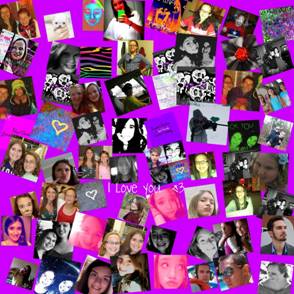
Facebook Collage by Christine Eberwein 11
Albert r. Reid
Assembly Room, A. K. Smiley Public Library
Friends
Developing and Maintaining Social Contacts 2012
Introduction New Behaviors
You’ve seen it I’ve seen it. People walking down the street or standing in an aisle in the store loudly having a conversation with absolutely no one. No one around them is listening. They just keep talking loudly and conversationally. Do they belong in a mental institution?
You've seen it I've seen it. Couples are sitting at a table in a dark romantic restaurant poking their fingers at a little black box either in their hand or on the table. They hardly look at each other. Do they hate each other? Are they just trying to avoid any face to face sweet nothings?
My wife and I were having dinner with our son, his friend and his friend’s fiancé. Someone would ask her a question and she would say " You should know that, I posted it on Facebook two days ago!" What is Facebook????
I saw a mother driving a car at dusk. Her two children are in the backseat. She is pulling out of a shopping center and on to a busy street glancing at traffic while looking at something in her hand while she turns and merges into traffic. Where is her attention? What is she looking at? I read that texting while you are driving is dangerous. Is that a surprise?
A Marine Captain nephew was returning from Iraq. His Mom started to organize a 1:00AM welcome home at Camp Pendleton. Mom was happy. He was coming home and he was safe; but, Mom was concerned she had not met his new girlfriend. She wasn't sure of what is going to happen. Mom and the new girlfriend are about to meet for the first time. The Captain, her son has "defriended" Mom on MySpace so he can talk to his girlfriend without Mom's commentary. This is why Mom who tried to organize the evening really doesn't know what is going to happen. I am not sure, but I thought that his mom & the girlfriend had different opinions about how to welcome him home. The couple first met on MySpace then met in person and continued their courtship won MySpace while he was in Iraq for a year. They are now married and now have two beautiful children.
This was the first time I heard about MySpace. I had heard about online dating services but this seemed different. During the Christmas Holiday that year our oldest daughter insisted that my wife and I each have a Facebook account. She sat down with us in the evening and set up a Facebook account for each of us. Thus our hands on experience began. It's interesting. What we read is both rewarding and frustrating. We post very little but we do follow our distant grandchildren's activities with interest.
We were already well aware of the advantages of e-mail. We could keep up with friends and even exchange pictures. It was much more convenient and cost less than snail mail.
We started receiving texts on our cell phones. These are usually short and to the point. They make a unique sound to let you know you have a message
Then, all of a sudden email seemingly stopped. It wasn't anything specific. There wasn't any warning or announcement - it just stopped. Period - zero - end - nothing! We still get lots of ads, junk mail, and endless forwards of interesting stuff which may or may not be true and a very rare personal email. Texts and Facebook seem to have replaced e-mail.
I don't understand why anyone wants to text? You can talk for heaven's sake. I find it very hard to hunt and peck with my thumbs on a miniature keyboard. At my best, I probably type on a real keyboard at 20 wpm and still have to go back and correct much of what I have typed . Texting with thumbs is ridiculous! I was fortunate for many years to have a wonderful secretary who could take dictation and correct my verbal idiosyncrasies. I didn't have to worry about my typing prowess or my spelling and punctuation.
Recently a college professor friend told me that his students don't answer e-mails anymore. They don't even look at their e-mail. They text everything. Since he usually tries to contact students that need help by email he is concerned.
Another thing. Online news articles now have comment sections after the article. Anyone can comment on any story that is posted by these news services. Usually many other readers have already commented. I can also post the article on Facebook or Tweet it. I can even click on the commenter's name and see every other comment he or she has ever made. Many comments don't seem to be informed or even literate. I can vote to make that story popular. Yahoo even has a service that records what Yahoo articles you have read. It posts links to those stories on your Facebook page so your friends know what you are reading.
These aren't isolated examples. We see them every day. The change has occurred very rapidly. Why?
All of these activities are called “social networking”. In the world of social networking you don't need to physically talk to, see or even personally know someone to have them as a social networking friend. It seems to me that the world is changing in ways that I had never anticipated.
Are these changes as pervasive as I see on the street or in the store? What is enabling these changes to occur? Are they an improvement or a step back?
There are several elements that enable these new practices.
- Personal computers have been available for over 25 years. Since their introduction, their uses have changed. In addition to word processing, spreadsheets, PowerPoint, and databases the early uses of the personal computer included email and some ability to converse on line using typed messages. Graphics were rare indeed. Chat rooms were popular. Games were simple. Computer users can now teleconference, play video games with others while they talk to them through headsets., watch entire movies in hi definition, post their own pictures and videos and much more.
- The internet When the internet was brought to personal computers it was slow and limited to low data intensive applications and some text based instant communication.. Today news and e-mail are old hat. High speed access to the internet has dramatically expanded the offerings the internet can provide. I'll talk more about that later.
- Social Networking Websites are a relatively recent innovation. They provide a place to post your personal information and contact others. They are used to find known friends and as a method to keep in touch and anyone can join. Many social networks are available. Some are personal some are special interest. Each one have different features. Most users now use their personal computers to expand their contacts with the outside world.
- Cell Phones - Normal cell phones, now called "feature phones" let you call text other users and take pictures or videos.
- A Smartphone also allows you to connect to the internet through the wireless network your phone uses. The Smartphone adds the capability to access the internet. The cell phone's evolution into a minicomputer with internet access has changed its role dramatically. Now you can access the internet, update your social network status, post your pictures, use it's GPS system to find out where you are and guide you to your destination, locate your friends or find a convenient restaurant for an unplanned meeting and so on infinitum. It is today's Swiss knife.
How does it all work together? Some statistics might also help understand the scope of what is happening.
Let's start with the computers and the internet. Americans are heavy internet users. The Nielsen Company monitors media usage. According to The Nielsen Company 85.9 million homes currently have broadband access to the internet. 211 million people are online. Additionally, 116 million people have mobile access to the internet. They use computers. Smartphone's, ipads and gaming consoles to access the internet.
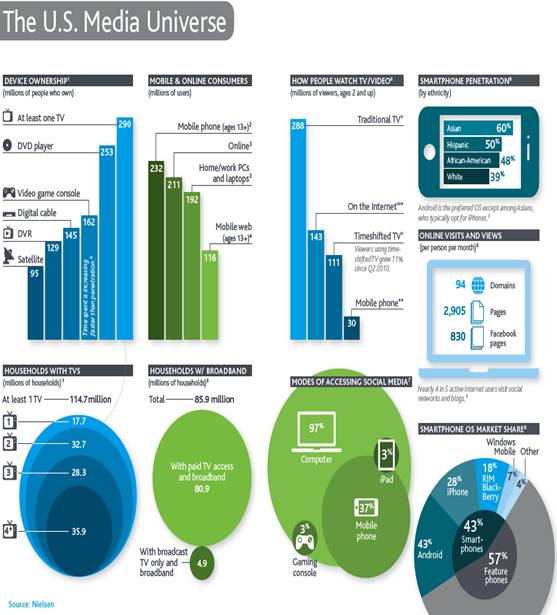
A large number of people send a great deal of time online. What do they do online?
Top 10 Sectors by Share of U.S. Internet Time |
RANK |
Category |
Share of Time |
Share of Time |
% Change in |
Jun-10 |
Jun-09 |
Share of Time |
1 |
Social Networks |
22.70% |
15.80% |
43% |
2 |
Online Games |
10.20% |
9.30% |
10% |
3 |
E-mail |
8.30% |
11.50% |
-28% |
4 |
Portals |
4.40% |
5.50% |
-19% |
5 |
Instant Messaging |
4.00% |
4.70% |
-15% |
6 |
Videos/Movies** |
3.90% |
3.50% |
12% |
7 |
Search |
3.50% |
3.40% |
1% |
8 |
Software Manufacturers |
3.30% |
3.30% |
0% |
9 |
Multi-category Entertainment |
2.80% |
3.00% |
-7% |
10 |
Classifieds/Auctions |
2.70% |
2.70% |
-2% |
|
Other* |
34.30% |
37.30% |
-8% |
Source:Nielsen NetView – June 2009-June 2010 |
*Other refers to 74 remaining online categories visited from PC/laptops |
**NetView’s Videos/Movies category refers to time spent on video-specific (e.g., YouTube, Bing Videos, Hulu) and movie-related websites (e.g., IMDB, MSN Movies and Netflix) only. It is not a measure of video streaming or inclusive of video streaming on non-video-specific or movie-specific websites (e.g., streamed video on sports or news sites). |
Where do social networking users go online? Wikipedia which is another form of virtual community lists nine Social Networking sites that have over 100,000,000 members.

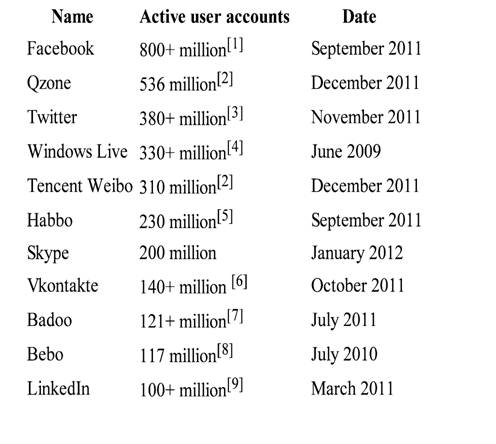
Clearly Facebook is the largest site. Interestingly, Facebook's initial membership was initially limited to Harvard students, but was expanded to other colleges in the Boston area, the Ivy League, and Stanford University. It gradually added support for students at various other universities before opening to high school students, and eventually to anyone aged 13 and over. However, based on ConsumersReports.org in May 2011, there are 7.5 million children under 13 with accounts, violating the site's terms of service.
Facebook members also tend to be the most active users. What they do when they visit a social networking site?
Frequency of use for users of different social networking site platforms
|
MySpace |
Facebook |
LinkedIn |
Twitter |
Other SNS |
Several times a day |
3% |
31% |
3% |
20% |
15% |
About once a day |
5% |
21% |
3% |
13% |
17% |
3-5 days a week |
2% |
15% |
4% |
6% |
14% |
1-2 days a week |
17% |
17% |
18% |
9% |
16% |
Every few weeks |
12% |
11% |
28% |
12% |
19% |
Less often |
33% |
5% |
35% |
23% |
14% |
Never |
29% |
1% |
9% |
18% |
5% |
% of users on the following social networking sites who use that site with the following frequency. For instance, 3% of MySpace users use the site several times a day. |
Source: Pew Research Center’s Internet & American Life Social Network Site survey conducted on landline and cell phone between October 20-November 28, 2010.
These sites are obviously fulfilling a need for their users. A large number of people spend a good deal of their time on these sites. What attracts so many?
Very simply they share their lives with their friends. They post their status, they post pictures, or videos, they follow what their friends are doing and comment on what they think of the activities of others. They also play games and watch videos.
What do users talk about when they post their status? When I visit a friend on Facebook I see a page that gives the friend's name and the friends picture. Usually it is a good image, but I have seen cats, dogs, shoes and even a snake representing that person. It also includes comments by the page owner and postings by other friends. Such as:
- "Had to give Maddie the Hound Dog some sedatives today. She slipped on the wood floor yesterday and set back her ACL healing on one of her back legs. Trying to keep her still for the next day or two to get back on the healing track. She looks so snuggly and cute--just wish she wasn't hurting. I guess after her pills, though, she's not feeling much pain at all!"
- "I just got home from work and my kitchen stinks. I can't find it. What can it be? It's not my daughter. She is away at college." (There were 11 comments within 18 hours) She never posted what caused the odor. I am still curious.
- "Right then, new target for the new year: Back to Weightwatchers, re-join the gym, take up a sport (boxing/kick-boxing/dancing) and lose weight :)"
- "Is it cause/effect or correlational when the length of the husband's business trip is related to at least one child waking up with a raging fever? Discuss."
Ok those are fun anecdotes. Let's look at the bigger picture?
On Facebook on an average day:
- 15% of Facebook users update their own status.
- 22% comment on another’s post or status.
- 20% comment on another user’s photos.
- 26% “Like” another user’s content.
- 10% send another user a private message
Remember there are over 800,000,000 users. 15% of 800,000,000 is 120,000,000 updates a day. That is a lot of posting.
Entertainment Weekly included the site on its end-of-the-decade "best-of" list, saying, "How on earth did we stalk our exes, remember our co-workers' birthdays, bug our friends, and play a rousing game of Scrabulous before Facebook?"[
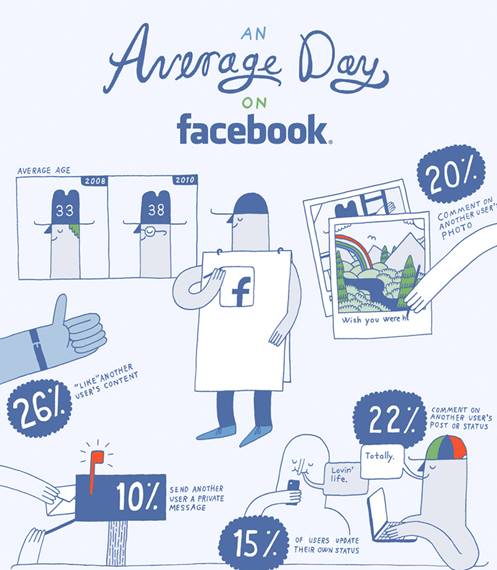
.
Who are the friends one finds? Facebook says the average user has 120 friends, However in an independent study higher numbers based on a telephone survey.
In the PEW sample, the average Facebook user has 229 Facebook friends. They reported that their friends list contains:
- 22% people from high school
- 12% extended family
- 10% coworkers
- 9% college friends
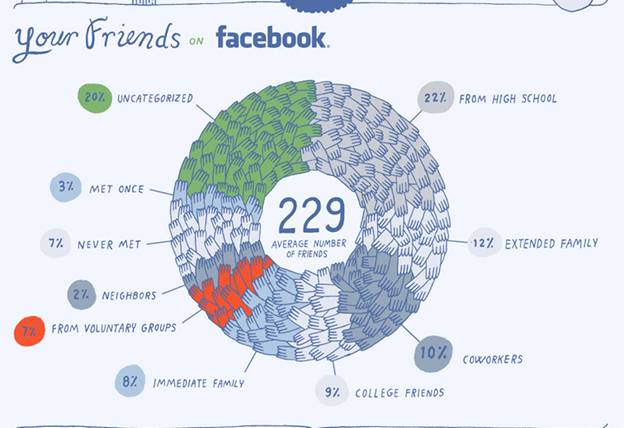
8% immediate family - 7% people from voluntary groups
- 2% neighbors
There are many other sites that provide contact for their users. Theses include subjects such as knitting & sewing, one lets you tell strangers what you thought about them, support groups for various medical conditions, genealogy, and movies as well as other subjects best not talked about in polite company.
All in all there is a good deal of activity communicating digitally with other people. Do people who actively communicate through social networks have more or fewer friends? Are their friendships closer or weaker? The PEW study tells us;
"...the more frequently someone uses the internet, the larger his network tends to be. The average person who uses the Internet at home several times per day, has a network of 732 ties, while someone who uses the Internet only once a day has a network of 616 ties.
In addition, mobile phone users average 664 ties, and those who have internet access through a mobile device like a Smartphone or tablet computer tend to have about 717 ties.
Other findings in the Pew Report include
Mobile phone use and instant messaging users are associated with having a larger overall network.
Overall, Americans have more close friends than they did two years ago.
The average user of a social networking site has more close ties and is half as likely to be socially isolated as the average American.
Facebook users have more close connections
- Internet users average 14% more discussion confidants than non-users.
- Those who use instant message average 12% more core confidants than other internet users, or 25% more than non-internet users.
- The use of SNS in general was not found to have a negative relationship with the number of overall close ties. However, frequent users of Facebook have larger core networks. For example, someone who uses Facebook a few times per day tends to have about 9% more strong ties.
In summary, it appears that adults who use social networks they truly do have more friends. These come from earlier in life as well as current contacts from all parts of a person's life. These contacts are kept up as people do watch what their friend are doing and communicate when they can.
Smart phones are a major part of the social networking world. The following charts are interesting. They have many different uses and their use is growing rapidly.
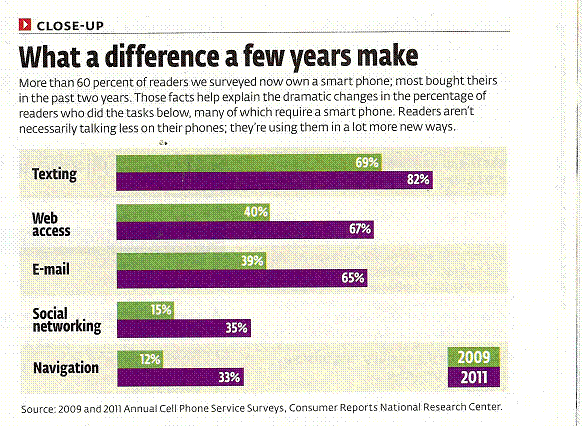
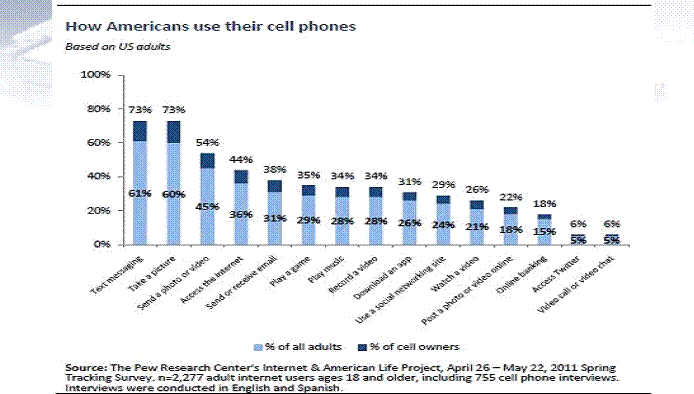
What about children?
A study entitled "The Impact of Facebook on Our Students" finds that:
Teenagers and preteens are very intensive users of the internet and of social networks
The greatest motivating factor for children to use technology in grades 7 and up is to connect to others; to socialize. Their irresistible need to connect with their peers, coupled with the development of 24/7 accessible technologies, can make the use of sites like Facebook all consuming. We have concerns for children and teens today growing up in a world where they are wired 24/7 without a break. For many of our kids there is little or no "down time." Some have difficulty disengaging from their social life. For some, it even raises their anxiety level to be without their cell phones for a few hours!
Let's look at some charts that tell us about relative usage by teens.
Fully 95% of all teens ages 12-17 are now online and 80% of those online teens are users of social media sites. Many log on daily to their social network pages and these have become spaces where much of the social activity of teen life is echoed and amplified—in both good and bad ways.
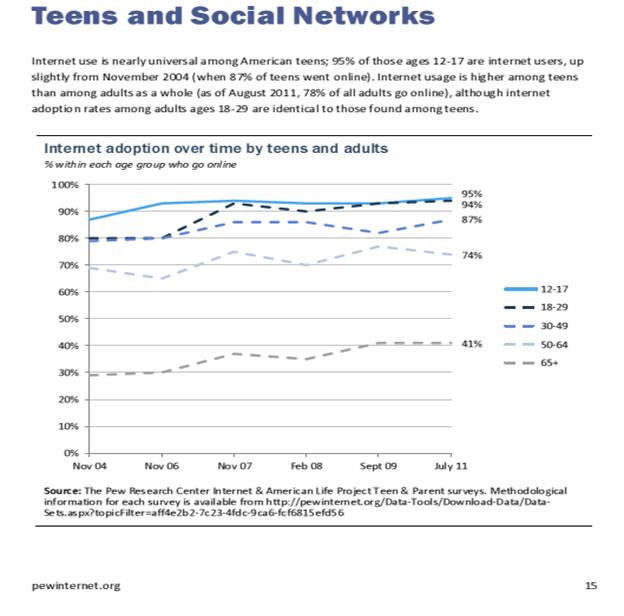
Our Fortnightly age group is a relatively light user of both social networks and texting. I know that we all have stories of our very young ones teaching us how to use the computer or the cell phone.
The following chart for teenagers indicates that they are much more active online than adults.
What Do Teens do Online |
Send instant messages or chat with a friend through the social network site |
88% |
Post comments on something a friend has posted |
87 |
Post a status update |
86 |
Post a photo or video |
80 |
Send private messages to a friend within the social network site |
76 |
Tag people in posts, photos or videos |
69 |
Play a game on a social network site |
50 |
Median # of activities |
6 |
Source: The Pew Research Center's Internet & American Life Teen-Parent survey, April 19-July 14, 2011. N=799 for teens 12-17 and parents, including oversample of minority families. Interviews were conducted in English and Spanish. |
|
I told you my view of texting earlier. Teenagers really use texting. My own private survey questions to teens from 11 to 18 indicates that if anything these numbers are low.

The Pew Study does discuss the teen view of social networks in a social sense. Generally the children see positives than negatives.
Adults are more positive than teens in their views.
The view of teenagers.
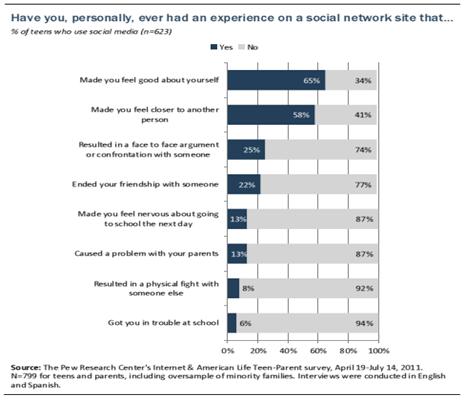 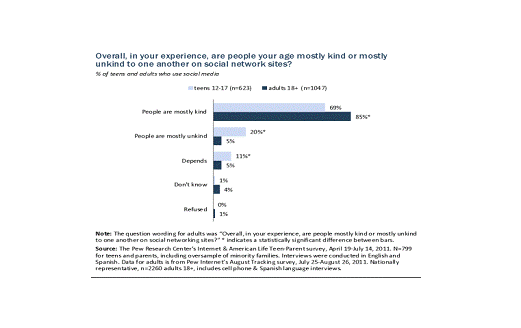
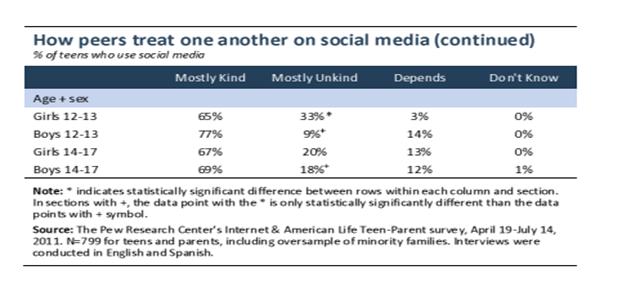
Between younger teens and older teens the younger girls seem to feel that their peers are less kind. Younger boys see their peers in a more positive manner.
Observations about Teenagers.
As we can see from these charts; and, from our personal experience, children and teenagers have been very quick to adapt to the new technology which literally seems to open the entire world for them. Has anyone in this room not asked an elementary school child how to do something on their computer or cell phone. These children are all very confident that they can handle themselves in this world better than adults.
This obvious creates some concerns. The literature has many examples of scams directed at the young that seem to succeed. The question of predators is also present. I didn't find much data to indicate the frequency of such activity. Never the less it does exist.
Given the percentage of children that now have access to these social networking sites it seems too late to ask the question of whether they should have access. Now the question is. How well the parents involved in their lives can influence and guide their actions.
There are many warnings by educational and parent groups. The major precaution they advise is that adults be aware of where children go on the internet and to be sure that the computer they use is visible in a main room of the house where it is visible to all..
Group Communication
Let's talk about lthe affect of social media on large groups.
A little over two years ago we received an email with a picture from our bicycle racer son. The picture was from the Los Angeles Times. In the picture he was riding just behind Lance Armstrong in a large group of riders. The night before Armstrong had tweeted "Hey LA - get out of your cars and get on your bikes. Time to ride. 7:30 tomorrow am. Griffith Park, LA Zoo parking lot. See you there."
Twitter users tweet in messages of 144 characters or less. I don't personally anyone who tweets. This tweet attracted several hundred cyclists to join him. our son described it as a mob.
The term "flash mob" is still new. This is a mob that gathers together as a result of communication on social media. Large crowds come together rapidly and seem to operate in a coordinated fashion.
There are flash mobs organized for fun and entertainment. One can communicate with their entire contact list at one time. If the next party also forwards your message to their entire contact list the numbers get very large with just a few cycles.
I have enjoyed flash mob videos of musical groups gathering in a shopping mall food court singing Christmas songs or spontaneously dancing on a beach. There is also a darker side to flash mobs . Flash mobs have shown major potential for violence .
In August 2011, after a riot near London that protested the killing of a man in a botched arrest a message was sent out from an anonymous source using blackberry messenger. The message read.
"Everyone in edmonton enfield woodgreen everywhere in north link up at enfield town station 4 o clock sharp!!!!
Bring some bags, the note went on; bring cars and vans, and also hammers. Make sure no snitch boys get dis, Link up and cause havic, just rob everything. Police can’t stop it."
Authorities became aware of this message in advance and placed a handful of police on the streets. At 5:00 PM everything seemed calm. A crowd of mostly young men was just milling around. At 6:00 PM as if by an invisible signal the streets exploded. Stores were invaded and looted. Police moved in and contained the crowd. As control seemed close new rioters came in by foot, train and car and overwhelmed the police. As police started to control one area the crowd seemed to disappear and reconstitute itself in another location. At one point an MP who represented the town buttonholed a rioter and asked him who they were and why they were there. The rioter simply said "Don't worry we'll be out of here soon?"
Similar riots have occurred around the world in recent years.
Some Conclusions
- A very large technologically driven change in personal communications has occurred in recent years.
- Social networking does enable people to maintain contact with many friends in a positive way. The degree of communication with friends is unprecedented. I suspect that most Fortnightly Members have had very little contact with their high school, college and military friends over the years. I notice that our children in their 40s have extensive contact with their high school friends over 20 years later. These friends are scattered all over the world. S ocial networking is improving our ability to stay in contact with friends both new and longstanding.
- On the negative side social media exposes children to influences beyond the ability of their parents to reasonably monitor and protect. Many are studying this area in an attempt to guide both parents and children in safe use of social networking.
- It also enables rapid organization of events and an ability to almost instantly communicate directions to mobilize members of a group such as a flash mob.
- Stay tuned, Social Networking will certainly get more interesting. Probably for the better and for the worse.
The Impact of Facebook on Our Students
By: Doug Fodeman & Marje Monroe
Published: January 23, 2009
Updated: February 10, 2009
Teens, Kindness and Cruelty on Social Network Sites
How American teens navigate the new world of "digital citizenship"
Amanda Lenhart Senior Research Specialist
Mary Madden Senior Research Specialist
Aaron Smith Senior Research Specialist
Kristen Purcell Associate Director, Research
Kathryn Zickuhr Research Specialist
Lee Rainie Director
Pew Research Nov 9, 2011
Lance Armstrong visits Griffith Park
September 10, 2009 | 10:16 am
Los Angeles Times
|